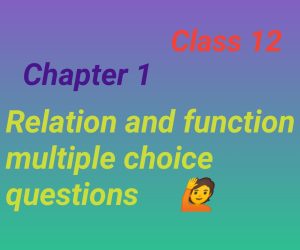EXERCISE 2.3 (Class 11)
1. Which of the following relations are functions? Give reasons. If it is a function, determine its domain and range.
(i) {(2, 1), (5, 1), (8, 1), (11, 1), (14, 1), (17, 1)}
(ii) {(2, 1), (4, 2), (6, 3), (8, 4), (10, 5), (12, 6), (14, 7)}
(iii) {(1, 3), (1, 5), (2, 5)}
Solution: (i) {(2, 1), (5, 1), (8, 1), (11, 1), (14, 1), (17, 1)}
In this relation no two ordered pair have same first element. Hence this relation is function
Here, domain = {2, 5, 8, 11, 14, 17} and range = {1}
(ii) {(2, 1), (4, 2), (6, 3), (8, 4), (10, 5), (12, 6), (14, 7)}
In this relation no two ordered pair have same first element. Hence this relation is function
Here, domain = {2, 4, 6, 8, 10, 12, 14} and range = {1, 2, 3, 4, 5, 6, 7}
(iii) {(1, 3), (1, 5), (2, 5)}
In this relation (1, 3), (1, 5) have first element same, Therefore this relation is not a function.
2. Find the domain and range of the following real function:
(i) f(x) = –|x| (ii) f(x) = √(9 – x2)
Solution: (i) Given,
f(x) = –|x|, x ∈ R
As f(x) is defined for x ∈ R, the domain of f = R(Real number).
We know that
|x| ∈ [0, ∞) ⇒ 0 ≤ |x |< ∞
⇒ –∞ < -|x| ≤ 0
⇒ -|x| ∈ (-∞, 0]
⇒ f(x) ∈ (-∞, 0]
Therefore, the range of f is given by (–∞, 0].
(ii) f(x) = √(9 – x2)
We know that
9 – x² ≥ 0 ⇒ (3 – x)(3 + x) ≥ 0
⇒ 3 – x ≥ 0 and 3 + x ≥ 0
⇒ x ≤ 3 and x ≤ -3
⇒ x ∈ [-3, 3]
So, the domain of f(x) is {x: –3 ≤ x ≤ 3} or [–3, 3].
Now,
For any value of x in the range [–3, 3], the value of f(x) will lie between 0 and 3.
Therefore, the range of f(x) is {x: 0 ≤ x ≤ 3} or [0, 3].
3. A function f is defined by f(x) = 2x – 5. Write down the values of
(i) f(0), (ii) f(7), (iii) f(–3)
Solution: Given,
Function, f(x) = 2x – 5
(i) f(0) = 2 × 0 – 5 = 0 – 5 = –5
(ii) f(7) = 2 × 7 – 5 = 14 – 5 = 9
(iii) f(–3) = 2 × (–3) – 5 = – 6 – 5 = –11
4. The function ‘t’, which maps temperature in degree Celsius into temperature in degree Fahrenheit is defined by ![]() .
.
Find (i) t (0) (ii) t (28) (iii) t (–10) (iv) The value of C, when t(C) = 212
Solution: Given function
![]()
(i) ![]()
![]()
(ii) ![]()
![]()
(iii) ![]()
![]()
![]()
(iv) t(c) = 212
Therefore
![]()
![]()
![]()
![]()
![]()
![]()
Therfore the value of t(c) when t(c) = 212 is 100
5. Find the range of each of the following functions:
(i) f(x) = 2 – 3x, x ∈ R, x > 0
(ii) f(x) = x2 + 2, x is a real number
(iii) f(x) = x, x is a real number
Solution: (i) Given,
f(x) = 2 – 3x, x ∈ R, x > 0
Since, x > 0
⇒ -3x < 0
⇒ 2 – 3x < 2
⇒ f(x) < 2
Range of f = (–∞, 2)
(ii) Given,
f(x) = x2 + 2, x is a real number
We know that,
x2 ≥ 0
⇒ x2 + 2 ≥ 2 [Adding 2 on both sides]
⇒ f(x) ≥ 2
Hence, Range = [2, ∞)
(iii) Given,
f(x) = x, x is a real number
Clearly, the range of f is the set of all real numbers.
Thus,
Range of f = R
https://gmath.in/ex-2-2-sets-ncert-maths-solution-class-11/
